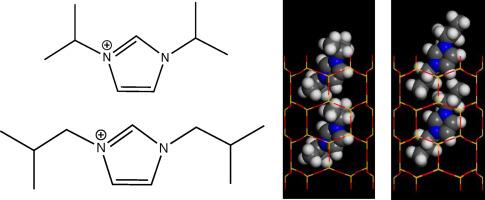来自烷基溴化咪唑离子液体的 MAPO-5 分子筛
IF 4.7
3区 材料科学
Q1 CHEMISTRY, APPLIED
引用次数: 0
摘要
使用离子液体二异丙基溴化咪唑(DIPI)和二异丁基溴化咪唑(DIBU)作为溶剂和结构引导剂(SDA),获得了 AlPO4-5 和 MnAPO-5 (Mn-AFI) 分子筛。随着锰含量的增加,DIBU 始终能得到纯相 Mn-AFI,而 DIPI 则会在锰含量超过 0.13 eq 时产生无定形产物。不同量的水、氢氟酸和金属会产生 AFI、嵴钙锰铁矿或三菱锰矿。我们还探索了使用镍作为金属掺杂剂,虽然在某些条件下获得了 AFI 相,但没有观察到金属的框架结合。由于 IL 的蒸气压非常低,因此合成过程不会产生压力升高的风险。ILs 易于完全回收并可用于多次合成。通过粉末 X 射线衍射 (PXRD)、热重分析 (TGA)、电子顺磁共振 (EPR)、多核固态核磁共振 (SS-NMR) 和 X 射线吸收精细结构 (XAFS) 对 MnAPO-5 材料进行了表征。这些发现为离子热合成掺杂金属的 AFI 框架提供了新的视角,并可能对催化应用产生影响。本文章由计算机程序翻译,如有差异,请以英文原文为准。

MAPO-5 molecular sieves from alkylimidazolium bromide ionic liquids
The ionic liquids diisopropylimidazolium bromide (DIPI) and diisobutylimidazolium bromide (DIBU) were used both as solvents and structure-directing agents (SDAs) to obtain AlPO4-5 and MnAPO-5 (Mn-AFI) molecular sieves. For increasing level of manganese, DIBU always yielded pure-phase Mn-AFI whereas DIPI led to amorphous product when more than 0.13 eq of Mn was added. Varying amounts of water, HF and metal led to AFI, cristobalite or tridymite phases. We also explored the use of nickel as the metal dopant, and although AFI phase were obtained under certain conditions, no framework incorporation of the metal was observed. Because of the vanishingly low vapor pressure of the ILs, the synthesis does not carry the risk of pressure build-up. The ILs were easily and fully recyclable and used for multiple syntheses. The MnAPO-5 material was characterized with powder X-ray diffraction (PXRD), thermogravimetric analysis (TGA), electron paramagnetic resonance (EPR), multinuclear solid-state nuclear magnetic resonance (SS-NMR) and X-ray absorption fine structure (XAFS). These findings provide new insight into the ionothermal synthesis of metal-doped AFI frameworks with possible implications in catalytic applications.
求助全文
通过发布文献求助,成功后即可免费获取论文全文。
去求助
来源期刊

Microporous and Mesoporous Materials
化学-材料科学:综合
CiteScore
10.70
自引率
5.80%
发文量
649
审稿时长
26 days
期刊介绍:
Microporous and Mesoporous Materials covers novel and significant aspects of porous solids classified as either microporous (pore size up to 2 nm) or mesoporous (pore size 2 to 50 nm). The porosity should have a specific impact on the material properties or application. Typical examples are zeolites and zeolite-like materials, pillared materials, clathrasils and clathrates, carbon molecular sieves, ordered mesoporous materials, organic/inorganic porous hybrid materials, or porous metal oxides. Both natural and synthetic porous materials are within the scope of the journal.
Topics which are particularly of interest include:
All aspects of natural microporous and mesoporous solids
The synthesis of crystalline or amorphous porous materials
The physico-chemical characterization of microporous and mesoporous solids, especially spectroscopic and microscopic
The modification of microporous and mesoporous solids, for example by ion exchange or solid-state reactions
All topics related to diffusion of mobile species in the pores of microporous and mesoporous materials
Adsorption (and other separation techniques) using microporous or mesoporous adsorbents
Catalysis by microporous and mesoporous materials
Host/guest interactions
Theoretical chemistry and modelling of host/guest interactions
All topics related to the application of microporous and mesoporous materials in industrial catalysis, separation technology, environmental protection, electrochemistry, membranes, sensors, optical devices, etc.
 求助内容:
求助内容: 应助结果提醒方式:
应助结果提醒方式:


